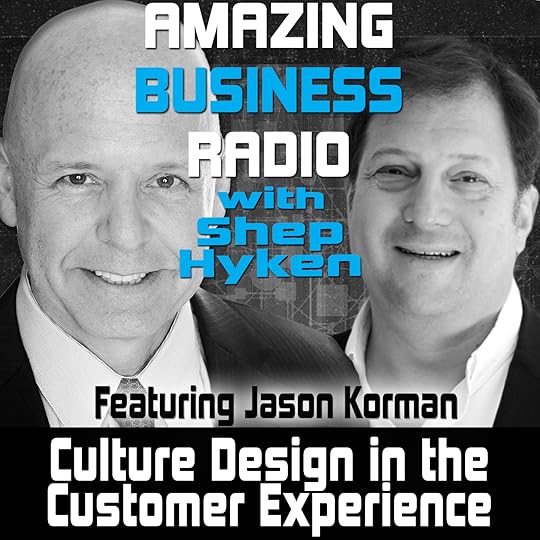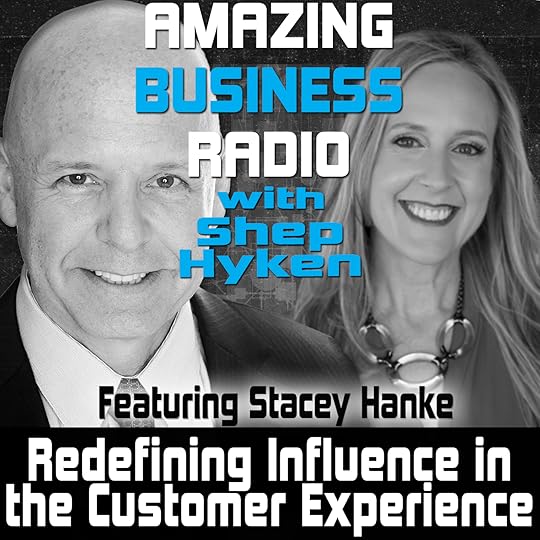Shep Hyken's Blog, page 104
June 15, 2020
5 Top Customer Service Articles For the Week of June 15, 2020
Each week I read a number of customer service and customer experience articles from various resources. Here are my top five picks from last week. I have added my comment about each article and would like to hear what you think too.
The Rise Of Premium Loyalty: What Do Your Customers Expect in 2020? by Retail TouchPoints
(Retail TouchPoints) In 2020, revenue is critical. And one of the biggest factors contributing to revenue is customer loyalty.
My Comment: This is a report you’ll have to download, so if you’re interested in customer loyalty (and who isn’t), then this is for you. The research in the report found that almost two-thirds of consumers surveyed say their loyalty is hard than ever to keep. The goal is to build revenue while building and earning your customers’ loyalty. You’ll find some good ideas in this report.
The 7 Rs of resiliency programs by Doug Reifschneider
(Retail Customer Experience) The 7 Rs of Resiliency Programs is a checklist that can help frame and direct the efforts to respond to COVID-19. It’s based on a mental framework from the US Marines that is centered on three steps in coping with a crisis: improvise, adapt and overcome.
My Comment: Resiliency is important in people and in business. Under difficult times, resiliency can be the difference between moving forward or potentially failing. As many businesses move into the post-pandemic phase, they should consider a resiliency strategy. This article uses the mental thinking of the US Marines to help look at how to reframe your business for success.
MarTech Interview with Christine Rimer, VP of Customer Experience and Advocacy at SurveyMonkey by Sudipto Ghosh
(MarTech) As the leader of customer experience and advocacy at SurveyMonkey, my work focuses on innovating CX for three specific areas: SurveyMonkey, our customers and the industry as a whole.
My Comment: At first, I thought this article was going to be about how to create better customer surveys, but that is not what it is about. Christine Rimer, VP of CX and Advocacy at Survey Monkey, talks about the success of the company, not about surveys. What really caught my eye was her comments about convenience, which was the focus of one of my recent books (The Convenience Revolution). Customers are very focused on convenience, so much so, they are choosing it over experience. As Rimer points out, convenience shouldn’t be separate from CX, but part of it.
Measuring Customer Experience: Metrics and the Benefits of Scorecards by Dick Bourke
(CustomerThink) Despite how trendy it is to talk about customer experience, few companies understand what it is. And that’s a significant problem because customer service is only a very small piece of the puzzle.
My Comment: Since we were just mentioning Survey Monkey, let’s dive into feedback and metrics. This short article addresses a number of different ways you can use metrics to better understand the customer experience you’re providing your customers – and how to make it better.
Proactive customer service drives greater retention, loyalty, and stories like these by Paul Selby
(CustomerThink) Though each day brings new hope, the pandemic continues to keep much of what was once “regular life” on hold. Society is not working, shopping, or traveling the same. Where this intersects with customer service is the abruptness of all the change and the uncertainty it brought for everyone.
My Comment: If there is one way to create more confidence with your customers, which leads to more business with them, it’s to deliver proactive customer service. In other words, helping your customers before they even know they need help. Paul Selby of ServiceNow shares his ideas on how to use proactive service to drive repeat business, and ultimately, customer loyalty.
 Shep Hyken is a customer service expert, professional speaker and New York Times bestselling business author. For information on The Customer Focus™ customer service training programs go to www.TheCustomerFocus.com. Follow on Twitter: @Hyken
Shep Hyken is a customer service expert, professional speaker and New York Times bestselling business author. For information on The Customer Focus™ customer service training programs go to www.TheCustomerFocus.com. Follow on Twitter: @Hyken
The post 5 Top Customer Service Articles For the Week of June 15, 2020 appeared first on Shep Hyken.
June 12, 2020
Guest Post: 4 Questions Your Call Center Employees Will Ask You During Crisis…And How to Answer Them
This week we feature an article by Chloe Sesta Jacobs, Head of People & Culture at Deputy. She provides crisis management strategies for call center employees during challenging times such as COVID-19.
Up until recently, we all thought we had a pretty good idea of what it meant to provide a high level of customer service. But customer service in the time of COVID-19 looks remarkably different. Traditionally office-based, many call centers are beginning to adopt remote working policies, and those companies that may not have operated call center facilities previously are opening up new lines of communication.
The good news is that, despite an initial panic, many organizations are taking action. They’re moving their staff to home offices to minimize the spread of the virus, and some are even setting up dedicated COVID-19 call center facilities to provide customers with additional ways to get in touch. These businesses are demonstrating that, in times of crisis, they can adapt quickly for operational continuity. But what many are overlooking is the fact that staff will have questions. And they want them answered.
So what exactly are your call center staff most likely to want to know during times of crisis? And more importantly, how can you answer these questions and ensure your staff has the information they need?
Let’s take a look…
1. How Will I Manage Increased Call Volumes?
Perhaps the biggest worry for your call center staff during times of crisis will be the potentially higher call volumes that they’ll be receiving. It’s essential that your staff feel supported during uncertain and challenging times, and that they have peace of mind that you have the tools you need to manage round-the-clock customer support teams accurately and efficiently. This may mean using digital solutions like automated callbacks and online chatbots, or integrated scheduling tools that optimize the value of call center staff and ensure the right agents are on hand, at the right time, to effectively handle capacity.
2. What Should I Tell Customers?
Your call center staff will need to know if there are any changes to standard business policies, such as changes to refunds, cancellations, or credits. However, it’s important that agents know that how they communicate during a crisis is equally as important as what they communicate. Insights firm McKinsey suggests that 64% felt depressed or anxious throughout the first few weeks of the COVID-19 pandemic. At these times, it’s human instinct to crave calmness and stability. It may be useful to create scripts so that your agents can speak with a unified voice and represent your brand as ready and prepared.
3. Who Can I Rely on for Help?
Your call center staff are accustomed to working in a collaborative environment. If they’re suddenly finding themselves working independently from home, they’re going to want to know who they can rely on for help and support with difficult cases. If possible, empower agents to make higher-level decisions to satisfy customer needs and concerns. Also, consider generating official documentation to be published online that your agents can direct callers to in order to see your company’s official response to the crisis. Finally, utilize communications tools that ensure you’re available when your team needs you the most.
4. Am I Doing a Good Job?
The answer to this question will be different for every agent. But the truth is that it’s an important question that your staff are likely to want an answer to. It’s reported that agents find it difficult to know if they’re doing a good job at the best of times, never mind during crisis. So use the crisis as a chance to review each approach, look at what’s working and where there’s room for improvement, and consider what changes could be made to help the business be better prepared to meet customer needs in challenging times. Convey this to your staff so that they can always be working to the best of their ability.
Growing from Crisis
During times of crisis, it’s natural to want to protect the business. But protecting the business means protecting your valuable human resources, and ensuring they have everything they need to do their job effectively. While things may be uncertain, one of the most effective ways to care for your staff at times like this is to be transparent, to answer their questions openly and honestly, and give them the tools and the information they need to succeed. Crises are challenging, but they also highlight the strength, power, and capabilities of your team. Embrace the chaos, and watch your team grow from the unexpected.
Chloe’s why is people; she gets her kicks from intensifying the purpose and exploring the potential of those around her. She works as Head of People & Culture at Deputy , a robust scheduling software that can be used to manage your workforce in a wide variety of different industries.
F
 or more articles from Shep Hyken and his guest contributors go to customerserviceblog.com.
or more articles from Shep Hyken and his guest contributors go to customerserviceblog.com.
Read Shep’s latest Forbes article: Post-Pandemic Predictions – June 2020
The post Guest Post: 4 Questions Your Call Center Employees Will Ask You During Crisis…And How to Answer Them appeared first on Shep Hyken.
June 10, 2020
Taking the Extra Step to Deliver Amazing Service
Sometimes a little creativity and extra effort can make a big difference in the customer experience.
One of our followers, David Turk, shared an article from a recent issue of the New York Times about how a server at an upscale restaurant “astonished” a guest with an amazing display of customer service.
The short version of the story is that a woman went to dinner at one of the finest restaurants in New York. From experience, she knew it was difficult to get her favorite beverage, Dr. Pepper, so she brought her own and requested a glass of ice—nothing else. When the server returned with a crystal glass filled with ice, she took the can of soda out of her purse and filled her glass. The server eventually took the empty can away. Several minutes later, he returned with another can of Dr. Pepper. She was, in her words, “astonished,” that the restaurant had Dr. Pepper. Well, it turns out they didn’t. The server “ran out to the corner bodega” and bought a can for her to enjoy.
I love that story, and it reminded me of a similar experience I had at a fancy restaurant. This restaurant was located in a beautiful office building. On the evening I dined there, I asked if they had root beer. The server said they didn’t, but he thought the soda machine in the lobby of the building did. In just a few minutes, he returned with a can of root beer and served it to me in a chilled beer glass.
Let’s break this down. There are at least three good lessons here:
Pay attention. In both instances, the servers were paying attention to their guests. Paying attention can help you find opportunities to deliver a better experience.
Care about your customers. The servers obviously cared about delivering a great service experience. They weren’t just going through the motions. It would have been easy for a server to ignore the guest who brought in Dr. Pepper, or to tell me, “I’m sorry. We don’t have root beer.”
Put forth extra effort. The servers were willing to put forth a little extra effort to take care of their customers. Going to the vending machine or “running to the corner bodega” doesn’t require a big effort, but it has a huge result.
This is about taking an extra step. It would have been easy for the server at the fancy New York restaurant to happily pour the can of Dr. Pepper into a glass for the guest, and that could have been it. It would have been easy for my server to tell me they didn’t have root beer. But in both cases, these two employees took the extra step or effort to ensure the experience was great—if not amazing!
What’s your customers’ version of these requests? Where can you show a little effort and creativity to add to the customer’s experiences? The result from a little extra effort taken can have your customers saying, “They are amazing!”
Shep Hyken is a customer service expert, keynote speaker, and New York Times bestselling business author. For information, contact 314-692-2200 or www.hyken.com. For information on The Customer Focus™ customer service training programs, go to www.thecustomerfocus.com. Follow on Twitter: @Hyken
(Copyright © MMXX, Shep Hyken)
The post Taking the Extra Step to Deliver Amazing Service appeared first on Shep Hyken.
June 9, 2020
Amazing Business Radio: Jason Korman

Culture Design in the Customer Experience
Engineering the Mindset and Behaviors Behind Good Customer Service
Shep Hyken interviews Jason Korman, CEO of Gapingvoid Culture Design Group. They discuss how culture impacts customer service and experience and strategies for designing the company culture.








Top Takeaways:
Culture and culture design are management systems. You must embed the right cultural norms into your organization in order to influence and drive the behaviors you want to see in your employees.
Think of your organization as a community of people who are tasked with certain outcomes. Help employees understand their purpose and the outcomes they are responsible for; in short, it’s about the employee mindset.
Shift the focus away from making money to taking better care of your employees and customers. That will drive better products and success for your company.
Customer service is affected by the mindset and psychology of the people who show up to work each and every day. This includes CEOs, managers and leaders, who must model the beliefs and behaviors they want to see across the organization.
Culture design is about programming the right mindset that will drive the best customer-focused behavior.
Leaders are hugely influential over a company’s culture, as people naturally emulate the behavior of those they perceive successful. Unfortunately, negative behavior spreads faster than positive behavior.
Zappos, for instance, uses their company culture as their brand. This is the biggest differentiator in their experience and what sets them apart from other companies.
Let customers’ high expectations for service directly inform and drive the experience you deliver.
Don’t only focus on core values—core values are the destination. You must map out the journey for your employees, which includes the right behaviors and beliefs that will get you to the destination.
Quotes:
“Culture actually is a management system. When you embed the right kinds of cultural norms into your organization, you influence the behaviors, mindsets and beliefs people have as they do the work.”
“The way we will sell more stuff and the way that we will succeed as a company is if we show up caring more about each other every day and caring deeply about our customers. Shift the focus from money to taking care of each other.”
“Customer experience is fundamentally an outcome of employee experience. If you want a great customer experience, you’ve got to create great employee experiences.”
“The customer’s expectation is what drives the experience.”
About:
Jason Korman is the co-founder and CEO of Gapingvoid Culture Design Group. He is a serial entrepreneur who has spent much of his life in the wine business.
Shep Hyken is a customer service and experience expert, New York Times bestselling author, award-winning keynote speaker, and your host of Amazing Business Radio.
The post Amazing Business Radio: Jason Korman appeared first on Shep Hyken.
June 8, 2020
5 Top Customer Service Articles For the Week of June 8, 2020
Each week I read a number of customer service and customer experience articles from various resources. Here are my top five picks from last week. I have added my comment about each article and would like to hear what you think too.
How Do You Maintain Customer Experience on a Shrinking Budget? by Phil Britt
(CMSWire) While the most common recommendation is to demonstrate the value of CX programs well before the budget ax falls, that tactic may be too late and not enough to avoid cutbacks in a sharply declining economy. We asked CX professionals how they would handle a reduced budget.
My Comment: Throughout the COVID-19 pandemic companies were forced to cut expenses, overhead, etc. I cautioned clients to be careful where they cut and to try and stay away from places where their customers would notice. This article looks at how to maintain a good CX, while at the same time, doing what’s necessary (in the form of cuts) for your business in trying times.
Got Emotional Connection? Then You’ve Got Profits by Heidi Tolliver-Walker
(WhatTheyThink) What is the secret to keeping customers from switching to a competitor with lower prices, faster curbside pickup, or a coupon that drops at just the right time? Motista, a provider of predictive intelligence, thinks it has the answer. Customer affinity. A look at the conclusions and data from its two-year study.
My Comment: You can’t have customer loyalty with an emotional connection with the customer. That emotion can come from the way the customer is treated, the confidence they have in the company’s products/services, the trust they have with the employees of the company and more. This great article is all about how the customer’s emotional connection drives profits.
More than just the customer service experience by David Beaumont
(David Beaumont) I have learned over the years the importance of saying the right things to people. There are three items I would like you to think about the next time you are engaging with someone. Whether it is with a family member, customer, employer, employee or business owner consider these three items.
My Comment: This article is a great follow up to the second entry this week on creating an emotional connection with customers. This one focuses on three ideas; how you treat people, what you say to people and your intention toward people. Three simple ideas to drive the emotional connection, thereby creating a better experience, thereby a reason for the customer to want to come back.
Adapting Your Customer Experience For a Post-COVID World – Joseph Michelli, Best-Selling Author by Atlanta Small Business Network
(ASBN) In this segment, Jim and Joseph talk about what your customer experience strategy should look like post COVID-19.
My Comment: I don’t often include a video in the TOP FIVE roundup, but couldn’t pass this one up. Jim Fitzpatrick of the Atlanta Small Business Network (ASBN) interviewed my friend, Joseph Michelli on how to adapt the customer experience as we come out of COVID-19. Enjoy the show!
5 Customer Experience Lessons From USAA by Blake Morgan
(Forbes) Companies in any industry can learn from the best. Here are five customer experience lessons from USAA.
My Comment: USAA has a long list of awards in the customer service and experience world. Year after year they are recognized for how well they treat their customers (members). Customer futurist expert Blake Morgan shares five ways they do it. Solid lessons here to benefit any type of business.
BONUS
7 Expert Customer Service Tips during the Coronavirus (COVID-19) Crisis by Dwayne Charrington
(ProProfs) The good news is that CX experts from big brands are ready to spill the beans with their valuable customer service tips during COVID 19. These tips will help you keep your business operations afloat and make you ‘live to fight another day’.
My Comment: Here is a compilation of customer service ideas from seven experts (myself included). I always enjoy “digesting” bite-sized tips that make me think about how to deliver better service. Here’s a quick read with some great ideas.
 Shep Hyken is a customer service expert, professional speaker and New York Times bestselling business author. For information on The Customer Focus™ customer service training programs go to www.TheCustomerFocus.com. Follow on Twitter: @Hyken
Shep Hyken is a customer service expert, professional speaker and New York Times bestselling business author. For information on The Customer Focus™ customer service training programs go to www.TheCustomerFocus.com. Follow on Twitter: @Hyken
The post 5 Top Customer Service Articles For the Week of June 8, 2020 appeared first on Shep Hyken.
June 5, 2020
Guest Post: 10 Ways Consumer Insights Help Improve the Customer Experience
This week we feature an article by Uma Bhat, a content marketing professional at Clootrack. She shares how businesses can utilize consumer insights to help improve customer service and experience.
Consumer insights have moved on from just supporting data for product improvement to being a core part of the strategic agenda at consumer-centric firms. As per market research, consumer insights have now become a top priority for as much as 80% of executives of large consumer products organizations. Consumer insights are key to understanding customer experience that enables marketers to direct and plan their product and marketing mix.
Today’s modern tech-savvy customers are expressing their customer experience in the form of product reviews, star ratings, consumer forums, social media, call recordings, comments on the website, and chat transcripts. This raw data can be converted into actionable consumer insights to be used to improve customer experience.
Here are 10 ways consumer insights help improve the customer experience:
1. Connects customer journeys instead of isolated interactions
Consumers have multiple channels of interactions – social media, customer care, online forums, and much more. Customers bounce between channels to express their expectations and displeasure at multiple points of their customer journey.
Consumer insights attempt to connect recognizable customer journeys across several platforms. Consumer insights aim to identify pain points and develop actionable responses with an astonishing degree of accuracy, thereby improving customer experience.
2. Tracks customer perception, not living with assumptions
Consumer insights give you an opportunity to track current customers and online audiences to identify discussions happening about your products. When a business starts tracking brand mentions, it can lead to a collection of honest feedback.
For example, through an analysis of 40,338 guest conversations, Clootrack created a list of customer perception drivers that visitors considered before booking a hotel room. It will give insights into what customers feel about your brand and opportunities to improve customer experience.
3. Reveals deep empathy, and not just data
Scores of unstructured consumer data can be used not just to find out ‘what’ consumers love or hate… but it goes on further to find out ‘why’ consumers like or dislike a product.
Consumer insights can pinpoint with great accuracy the deep empathy embedded in the consumer data. This empathy can go a long way in shaping delightful customer experiences.
4. Continuous insights, not a one-time study
Consumers tend to change their buying behavior very often and unexpectedly. This gives more reasons for brands to stay on top of customer behavior with the help of consumer insights.
Analyzing consumer insights is a continuous process rather than a one-time study. Consumer insights are much needed for the continuous improvements to your customer experience, instead of leaving you scrambling to keep up later.
5. 360-degree review of customers, not just the surface level
With the help of the customer data from different sources, a comprehensive 360-degree review of customers is now possible. Armed with consumer insights, brands can dig deeper to see what’s hidden within the customer data, and by using this, companies can create a cohesive, real-time picture of their customers, thus leading to better customer experience.
6. Drives strategic business decisions, not just metrics
Highly data-driven organizations are three times more likely to report significant improvement in decision-making, according to PwC research. Rather than “going with a gut feeling,” consumer insights provide a treasure of information, which companies can use to drive strategy, sales, marketing, and product development.
Using granular consumer insights enables companies towards faster and fact-based decision making, and thereby enjoy improved customer experience.
7. Plan product improvements, not disappointments
“Consumers themselves are changing quickly. Insight communities allow us to bring the perspective and needs of our consumers into the product development process early on.” – Kate Pinkham, VP Consumer Insights at Wolverine Worldwide.
Every brand can build a product that is desired by its customers. The only way to do this is to know what people want – by using consumer insights.
8. Aids customer service, not dissatisfaction
Customer service is all about making your customers fall in love with you. For example, “I don’t like their refund policy” and “I was waiting for 28 days with no clue about my refund.”
The first sentence is generic and suggests that the refund policy is not good, whereas the second example states the exact waiting period. Deep consumer insights enable you to analyze customer pain points.
9. Personalize customer journey, instead of generalizing efforts
Brands have to customize their marketing efforts to give excellent customer experience. It’s important to get deeper to understand how potential consumers perceive different products and what they need from a particular range of products.
With such deep customer data, marketers can personalize customer requirements by offering dynamic content, personalized ads, and product recommendations. This leads to an enjoyable customer experience.
10. Speed is the need, instead of going out of context
To gain delightful and meaningful customer experience, companies need to reach their intended audiences at the right time with the right offers and using the right channels. If it’s too late, the context would have changed, and the entire exercise would be a waste of time.
Consumer insights can be derived almost real-time, and hence most useful to enhance the customer experience.
Key takeaway
“Customer Experience is not just one event, but the combination of interactions that provide value each time,” says Monique Gravel, Customer Experience Manager.
Customer-centric companies have realized that ‘how they deliver’ is as important as ‘what they deliver.’ With the help of consumer insights, companies are learning more about their customers, and are integrating the learning into delivering better customer experiences.
Uma Bhat is a content marketing professional at Clootrack, a market intelligence platform. She writes about consumer insights and market intelligence, and how businesses can improve customer experience using consumer insights.
F
 or more articles from Shep Hyken and his guest contributors go to customerserviceblog.com.
or more articles from Shep Hyken and his guest contributors go to customerserviceblog.com.
Read Shep’s latest Forbes article: The Comeback Of Conferences And Meetings
The post Guest Post: 10 Ways Consumer Insights Help Improve the Customer Experience appeared first on Shep Hyken.
June 3, 2020
Ridiculous Interpretation of Rules
This is one of those unbelievable customer service stories that borders on the ridiculous. I actually thought I was in the middle of a Seinfeld episode—or maybe there was a hidden camera hoping to get a crazy reaction to the interaction I’m about to share with you.
I was at an airport and wanted some breakfast. There was just one person ahead of me in line. I heard her order a bacon, egg and cheese sandwich, hash browns and an orange juice. After placing her order, she stepped aside. The woman behind the counter asked what I’d like. I responded, “I’ll have exactly what that customer in front of me just ordered.” The employee looked up at the clock and said, “Breakfast is not served after 10:30.”
What?! That woman just ordered ten seconds before I did. Could it be 10:31, one minute after? Did it really matter? On top of that, I could see a number of egg sandwiches warming in the oven behind her, ready to be sold to hungry customers like myself.
I asked if she was serious, and she gave me a cold stare and repeated herself, “Breakfast is not served after 10:30.” Directly next to this quick-serve restaurant, was another restaurant. The manager of that restaurant was watching what had just unfolded and said, “Sir, we’ll be happy to serve you breakfast.”
Of course, I took him up on his offer. We had a good laugh about it, and I knew I had some new material to write about.
There are rules and then there are “rules.” In a world where customer service and experience is as important as ever, it is important to properly train and empower employees to say “yes” to a customer whenever possible—as long as it is a win/win for both the customer and company. This means teaching when to be flexible. Some rules can’t be broken. That can include anything that might harm an employee or customer, something illegal and more. It’s important to let employees know what those hard and fast rules are. Then teach them that most other “rules,” as they might see them, are more like guidelines that can have a degree of flexibility built into them.
What could the woman taking my order at that first restaurant have done? She could have looked over and noticed there were plenty of breakfast sandwiches and said, “This is your lucky day. Normally, we stop serving breakfast at 10:30, but it looks like we still have some breakfast sandwiches.” I would have loved that. I might have even shared that story—about how she used common sense to take care of her customer.
What we’re trying to avoid is a ridiculous or extreme interpretation of rules. The reasons to be diligent about enforcing certain rules are obvious, as already stated, and must be taught. Examples of extreme interpretation should also be taught. When taught properly, employees will know the difference between what they can and should do—and what they can’t and shouldn’t.
Shep Hyken is a customer service expert, keynote speaker, and New York Times bestselling business author. For information, contact 314-692-2200 or www.hyken.com. For information on The Customer Focus™ customer service training programs, go to www.thecustomerfocus.com. Follow on Twitter: @Hyken
(Copyright © MMXX, Shep Hyken)
The post Ridiculous Interpretation of Rules appeared first on Shep Hyken.
June 2, 2020
Amazing Business Radio: Stacey Hanke

Redefining Influence in the Customer Experience
Showing Up as Your Best Self to Create the Best Customer Experience
Shep Hyken interviews Stacey Hanke. They discuss Stacey’s book, Influence Redefined…Be the Leader You Were Meant to Be, Monday to Monday® and how redefining your concept of “influence” can revolutionize your customer experience.








Top Takeaways:
Influence is not what most people think it is. It’s not something you can turn on and off, but is instead about consistent messaging (both verbal and nonverbal) that drives people to action.
Customer service is all about relationships. Those relationships are built over time through consistent communication and interactions. Predictability and consistency are the foundation for a good customer experience.
Remember that communication happens both through language and through nonverbal cues such as body language and facial expression. All of this has an effect on the experience as a whole.
What does it mean to be yourself? It’s about bringing your best self to every interaction and every single day. Remember that your name is on every single thing you do.
The 3-step process to redefining and expanding your influence is as follows:
Make sure you get feedback instead of fluff. Get the truth from people you trust. Find out what works to enhance your influence, and what is getting in your way of influencing your customers.
Deliberate practice is crucial. Once you know what is working and what isn’t, you must practice to make the changes you want to see.
Be accountable. If you don’t ask for feedback, you will go through life based on feelings instead of facts. Find people you trust to help keep you accountable.
Start small. Identify ONE thing that you could have done better, and work to improve that in your next interaction. That’s how you make progress and ultimately, big changes.
Deliver feedback in a supportive, kind and helpful way. This does not mean you should be dishonest. It doesn’t cost anything to be nice.
Above all, be kind to each other. You never know what someone may be going through or dealing with. And you never know when you may need that kindness from others.
Quotes:
“Influence is so much about how we show up and present ourselves every single day. How we communicate Monday to Monday, both verbally and nonverbally, determines the level of influence we really have.”
“Customer service is all about building relationships. Relationships aren’t built through one email or interaction. It’s a series of how someone experiences you over a timeframe where that trust and that influence is built.”
“We always hear ‘be you.’ But what does that mean? To me, it means the best of you shows up every day.”
About:
Stacey Hanke is the founder of Stacey Hanke, Inc. and the author of Influence Redefined…Be the Leader You Were Meant to Be, Monday to Monday®. She has trained and presented to thousands on word choice and body language.
Shep Hyken is a customer service and experience expert, New York Times bestselling author, award-winning keynote speaker, and your host of Amazing Business Radio.
The post Amazing Business Radio: Stacey Hanke appeared first on Shep Hyken.
June 1, 2020
5 Top Customer Service Articles For the Week of June 1, 2020
Each week I read a number of customer service and customer experience articles from various resources. Here are my top five picks from last week. I have added my comment about each article and would like to hear what you think too.
3 Things That Will Boost Your Reputation For Great Customer Service by Mark Armstrong
(Business2Community) I’ve been a freelance illustrator for 30 years. I’ve dealt with a lot of different people. These days, there are three things I focus on when it comes to customer service.
My Comment: We start this week’s roundup with a very short article (two-minute read) about three simple ideas to increase loyalty; keep customers informed, no surprises and good follow-up. Sounds like common sense, doesn’t it? Take a couple of minutes to read this and then remind your people about these three simple ideas that will help you be even more successful.
3 Customer Service Lessons from Pella Corporation by Elena Constantinescu
(Smarter CX) This article shares how Pella improved their strategy, technology, and metrics to deliver exceptional experiences.
My Comment: Another article with three ideas, this time from a world-class organization, Pella (the door and window company). I always love learning from great companies, and Traci Scott of Pella shares three interesting strategies they use to deliver great service. She reminded me of a favorite quote at the end of the article: “If you want to see where a company is at, look at their sales, but if you want to see where a company is going, look at their service.”
How to improve call center performance when there is a staff shortage by Krishna Charan
(Freshworks) From this blog, you can find out actionable workarounds for staff shortage to improve call center performance.
My Comment: If you are in a customer support/contact center, then this article is a must-read. What happens when there is an increase in customers reaching out for support? How can you predict or forecast? How do you scale up? Here you’ll find some “workarounds” for those times you are short-staffed and want to maintain your support center’s reputation for excellent service.
Improving Customer Experience By Creating An Omnichannel Experience by Cameron Weeks
(Forbes) Technology makes it simple to connect to the world without moving an inch. So, why does connecting with the companies that we buy from feel more difficult?
My Comment: Multichannel and omnichannel may not be the most exciting topics in the world, but they are very important to your customer (even if they don’t know it), and even more important to you. Cameron Weeks, co-founder and CEO of Edify, shares some ideas on the difference between the two, customers’ expectations and tips on how to get the best out of an omnichannel strategy.
Rebuilding the Economy Around Good Jobs by Zeynep Ton
(Harvard Business Review) In countries hit by the Covid-19 pandemic, customer-facing service businesses don’t just face a tough two to three months; they face a tough two to three years. Because people will still be nervous about catching the disease until a vaccine is widely available, demand is likely to be depressed, while costs — due to measures needed to keep employees and customers safe — will be higher.
My Comment: We close out this week with a Harvard Business Review article on the rebuilding of our economy with good jobs – versus bad jobs. In short, bad jobs equals bad performance. Part of the author’s suggestion is higher pay. That works in some cases, although I’m not entirely comfortable with her explanation. But, consider why it’s important to have good people in good jobs doing good work. The stat in the article from the retail industry is a good reason to pay to get your best people doing their most productive work. In the US, there are 24.5 feet of retail space per person versus 16.4 feet in Canada and 4.5 square feet in Europe. The author nails it. “This is certainly too much and the mediocre, the ones that don’t make their customers want to come back, will not survive.”
 Shep Hyken is a customer service expert, professional speaker and New York Times bestselling business author. For information on The Customer Focus™ customer service training programs go to www.TheCustomerFocus.com. Follow on Twitter: @Hyken
Shep Hyken is a customer service expert, professional speaker and New York Times bestselling business author. For information on The Customer Focus™ customer service training programs go to www.TheCustomerFocus.com. Follow on Twitter: @Hyken
The post 5 Top Customer Service Articles For the Week of June 1, 2020 appeared first on Shep Hyken.
May 29, 2020
Guest Post: 4 Inputs of a Customer-Centric Culture Transformation
This week we feature an article by Annette Franz, CCXP; founder + CEO of CX Journey Inc. She shares tips on how to create an effective customer-centric company culture.
There’s a lot of talk about customer-centricity and customer-centric organizations, but what does that really mean? Sadly, many people think that it’s all about just giving the customer what she wants, saying “yes,” and bending over backwards for her. That’s not it at all. If your business is customer-centric, those things are the least of your worries.
Customer-centric companies put the customer at the center of all they do. That means that they ensure that they make no decisions without first thinking of the customer and the impact those decisions have on the customer. The customer is infused into everything they do. I like to say: No discussions, no decisions, no designs without bringing in the customer and her voice, without asking how it will impact the customer, how it will make her feel, what problems it will help her solve, what value it will create and deliver for her.
As I’ve been writing and talking about customer-centricity, I continue to land on four inputs that feed into and inform a customer-centric culture. Let me explain each one here.
1. Leadership
An important thing to note about a customer-centric culture is: it is deliberately designed to be that way. It doesn’t occur by accident. This design comes from the top, from the CEO. The CEO (and the entire leadership team) must be committed to bringing the customer voice into all they do. The leadership team must communicate to employees what it means to be customer-centric and how it impacts the work they do. That also means that they must lead by example and model customer-centric behaviors.
To further perpetuate, they’ve got to recognize and reinforce behaviors that are in line with customer-centric expectations. Reinforcing the behaviors and actions that you want to see –especially when combined with modeling them – is more powerful than simply talking about them. Remember: you get what you allow; what you allow must align with what you’ve designed.
In addition, leaders must always put people first and recognize that their employees’ needs come before their own. This should be a basic tenet of any culture: people first, and the numbers will come.
2. Core Values
To further support that the customer-centric culture is deliberately designed, the company’s core values must align with and support customer-centricity. Examples of customer-centric values include: customer-focused, people first, customers first, deliver WOW through service, customer obsession, obsess about our members, focus on the customer and all else will follow, build strong relationships to create guests for life, innovate, etc. You get the idea. You don’t have to have values that mention the customer, just values that align with the customer-centric culture that you are trying to create.
And to that last point, it’s not enough to just have core values; you’ve also got to define associated behaviors. Go through the exercise of outlining examples of acceptable and unacceptable behaviors relative to each value so that there is no question of what they mean or how they translate to customer-centricity. And don’t forget, policies and processes must be designed with the values in mind so that employees can and will, without pause or question, always do the right thing.
3. Employees
There’s no customer-centric culture if it’s not lived by employees. (Well, there is a culture, but it’s not the one you want or have designed for.) Values are meaningless unless they inspire and drive the behavior that you expect your employees and executives (they’re not exempt!) to display. In other words, your core values mean nothing if everyone in the company doesn’t live them. Once you’ve established the behaviors related to each core value, you’ve got to ensure that employees have the proper training, tools, and resources to live and breathe them. And they must be empowered to do what you expect them to do.
It might surprise you to hear, too, that hiring for culture fit is important to getting the customer-centric culture you want. You’ve got to get the right people on the bus, the people whose values and purpose align with your company’s value and purpose. Hire for attitude, train for skill. When you hire people who care about people, a customer-centric culture is much easier to create.
Establish a Culture Committee to meet regularly to identify, discuss, and plan ways to promote and to drive the desired culture throughout the organization. This committee helps to create that groundswell of adoption throughout the organization of the culture traits as defined by the core values and corresponding behaviors.
4. Customers
Customer understanding is the cornerstone of customer-centricity. You can’t have a customer-centric culture without customers, without bringing the customer voice into the business! A customer-centric culture is informed by customers. A customer-centric business understands and knows that business is all about the customer, that the purpose of a business is to create and to nurture a customer.
Customer understanding is achieved in three ways: (1) listen (feedback and data), (2) characterize (research-based personas), and (3) empathize (journey mapping process). The critical part of customer understanding is to do something with what you learn. You’ve got to act on it. You’ve got to bring these learnings into every discussion, decision, and design. You’ve got to use the data and the insights to design and deliver an experience that solves customer problems, helps them achieve the jobs they are trying to do, and addresses their pain points. In short, you’ve got to deliver value to your customers in order to achieve business value. This is the heart and the spirit of customer-centricity.
***
As you can see, a customer-centric culture isn’t just about giving customers what they want. There’s a foundation – these four inputs – that must be in place to ensure that customers are at the heart of all the business does. Do you have all four of these components feeding your customer-centric culture?
Annette Franz is the founder and CEO of CX Journey Inc. She’s got more than 25 years of experience (both client side and vendor side) helping companies understand their employees and customers and identify what drives retention, satisfaction, engagement, and the overall experience – so that employees, customers, and businesses reap the benefits and achieve their desired outcomes.
F
 or more articles from Shep Hyken and his guest contributors go to customerserviceblog.com.
or more articles from Shep Hyken and his guest contributors go to customerserviceblog.com.
Read Shep’s latest Forbes article: Four Ways To Build Trust Through Social Proof
The post Guest Post: 4 Inputs of a Customer-Centric Culture Transformation appeared first on Shep Hyken.





